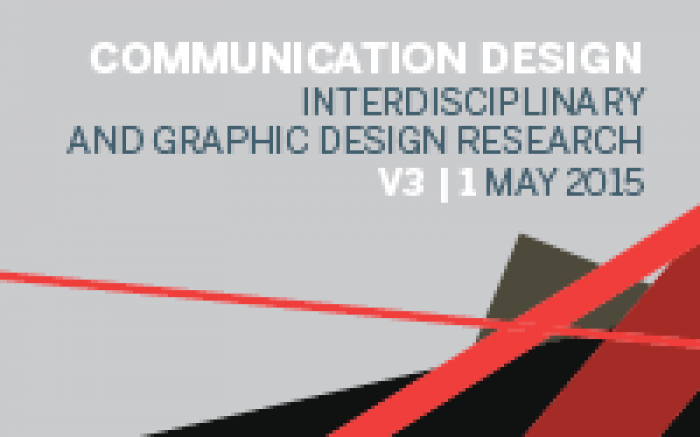the journey of a design journal

02.03.2016 Features
“Communication Design is a lens through which emerging discourses in contemporary communication design research and professional practices are made manifest, critically examined and developed.”
- Editor-in-chief of Communication Design, Interdisciplinary and Graphic Design Research 3(1) Teal Triggs
From an analysis of the aesthetics of branding ‘urban black anti-hero style’ for an American sport apparel company in an article by Bobby Campbell, to Michele Buchanan’s piece entitled ‘@facevalue // expanding our typographic repertoire’, Communication Design, Interdisciplinary and Graphic Design Research is the new face of the online peer-reviewed journal. It is the official publication of the International Council of Design (ico-D), published in partnership with Routledge (Taylor & Francis Group), a journal that explores new directions of contemporary design practice and research.
The launch of Communication Design, Interdisciplinary and Graphic Design Research Volume 3 (Issue 1) with a cover by prominent designer Neville Brody, is a significant evolution that builds upon a dynamic publishing history in the Council. Led by Editor-in-chief Teal Triggs and supported by an accomplished editorial team, including leading authors on design, Communication Design proposes to follow, through the lens of scholarship, the legacy of its predecessors: Icographic and Iridescent. In her editorial for the journal, Triggs describes how Communication Design will continue to become a ‘prism on design research’ in that it can ‘filter the luster and see what it is composed of’ - Dutch writer and Iridescent’s first supervising editor Max Bruinsma.
The 'journey of a design journal', the flash narrative and visuals created for the recent launch of the first issue of Communication Design:


In her editorial, Triggs asserts that the journal carries the same mandate as before, always striving to reflect what is ‘becoming’ in the world of design. She traces the journal’s publication history and goals: in 1971, the first issue of Icographic was released, and was “a journal that sought to establish a benchmark for visual communication design research with an aim to make such explorations available to a broad international audience. Icographic was notable for the publication of articles by both practitioners and academics, and for rich graphic imagery from designers around the world.”
The journey toward interdisciplinary design research that the journal has undergone is evident from the earliest scholarly coverage of design: research into sign perception, typefaces for bilingual printing, new technologies of laser holography, the role of the book designer, changing responsibilities of the typographic designer, problem-solving in the man made environment, and design from the perspective of a woman designer.
Years later, Icographic evolved and became Iridescent, “a journal published in 2009-2011, born out of the Council’s strategic aim to support the development of communication design education including interdisciplinary facets of theory, practice and research.”
The name change to Communication Design considered the need to give space for new definitions of design given the breadth of expanding design realities and expressions.
In the present Volume 3 (Issue 1), the topics show a harmonious conversation taking place in the design world between ‘traditional’ and ‘new’ media. Through visual and text-based essays, articles, archives and reviews, the subjects cover a range of new views on design, including: case studies that “map the explicit interactions among people, objects and systems,” continued scholarship on typography and type design, the investigation into the branding of urban subcultures, as well as reviews of exhibitions and practitioner-based approaches to research. Catherine Moriarty’s article: ‘The Archive of the International Council of Graphic Design Associations at the University of Brighton’ emphasises the need to expand the history and theory of design, the behind-the-scenes insights into the processes, business and design decisions that are taken to produce archives. This ‘paper trail’ of knowledge that could inform future design practice is particularly noteworthy for ico-D Members and Community.
The cover concept and design is created by leading typographer and art director British-born Neville Brody of RDI, Brody Associates, who first came to international attention in the 1980s with his work as Art Director of The Face magazine and through his innovative record cover designs for Stiff Records. Professor and Dean of the School of Communication at the Royal College of Art, London, Brody brings his experience to the academy in creating a new vision for the future of design education.
At the release of this new journal, Triggs asks that we revisit what we mean by the term ‘communication design’, and to take into consideration the nature of design as an ever-expanding and -becoming practice. The future of design is broadening from the design of the visual to also include the design of sound, haptics, experiences and services. And as a result, she says “it might be argued that the term ‘communication design’ better describes and supports a range of new kinds of practices, processes, and methods.” Communication Design intends to be the vehicle to communicate this ‘becoming’ in design to you.
The 'journey of a design journal' continued:








Subscribe to Communication Design 3 (1).
ico-D Members receive a 30% discount offer.
Contact subscriptions@tandf.co.uk for assistance.
http://www.tandfonline.com/pricing/journal/rfcd20
Submit to Communication Design 3 (2).
For more information contact:
Alisha Piercy
Communications Officer
International Council of Design (ico-D)

relatedarticles

goodbye! and next steps for colleague and friend alexey lazarev

explorations in ethical design: meditations on equality

RCA launches new programme: MA Digital Direction

Interview | Ermolaev Bureau (Moscow)
